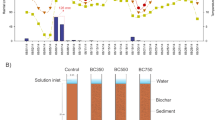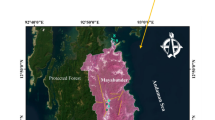Abstract
Sediment samples were collected from six springs draining the karst aquifer at Fort Campbell, Kentucky/Tennessee. These were analyzed by ICP-MS following an extraction procedure that separates the metals into exchangeable, carbonate, oxide, organic and residual fractions. Aluminum and iron are primarily present in the residual fraction while manganese may be dominantly in either the oxide or carbonate fraction. The redox-sensitive metals (Fe and Mn) have the greatest fractional distribution in the spring with the thickest sediments. Trace metals detected include Cr, Cd, Ni, Pb, and Zn in the range of a few to 200 mg/kg. In Beaver Spring, nickel is distributed between the exchangeable, carbonate and organic fractions, while in Gordon Spring, nickel is largely residual. Chromium is almost entirely associated with the organic fraction in Beaver Spring while it is largely residual in Gordon Spring.













Similar content being viewed by others
References
Apodaca LE, Driver NE, Bails JB (2000) Occurrence, transport, and fate of trace elements, Blue River Basin, Summit County, Colorado: an integrated approach. Environ Geol 39:901–913
Atteia O, Kozel R (1997) Particle size distributions in water from a karstic aquifer: from particles to colloids. J Hydrol 201:102–119
Bendell-Young LI, Thomas CA, Stecko JRP (2002) Contrasting the geochemistry of oxide sediments across ecosystems: a synthesis. Appl Geochem 17:1563–1582
Brady NC, Weil RR (1996) The nature and properties of soils. Prentice Hall, Englewood Cliffs, NJ, 559 pp
Byrne RH, Kump LR, Cantrell KJ (1988) The influence of temperature and pH on trace metal speciation in seawater. Mar Chem 25:163–181
Chakrapani GJ, Subramanian V (1993) Heavy metals distribution and fractionation in sediments of the Mahanadi River basin, India. Environ Geol 22:80–87
Gundersen P, Steinnes E (2001) Influence of temporal variations in river discharge, pH, alkalinity and Ca on the speciation and concentration of heavy metals in some mining polluted rivers. Aquat Geochem 7:173–193
Johnson BB (1990) Effects of pH, temperature, and concentrations on the adsorption of cadmium on goethite. Environ Sci Technol 24:112–118
Kemmerly PR (1980) Sinkhole collapse in Montgomery County, Tennessee, State of Tennessee Division of Geology. Environ Geol Series No. 6, 37 pp
Klemic H (1966) Geologic map of the Oak Grove Quadrangle, Kentucky. U.S. Geological Survey
Klemic H (1974) Geologic map of the New Providence Quadrangle, Kentucky. U.S. Geological Survey
Luther ET (1977) Our restless earth. The geologic regions of Tennessee. University of Tennessee Press, Knoxville, TN
Mahler BJ, Lynch FL (1999) Muddy waters: temporal variation in sediment discharging from a karst spring. J Hydrol 214:165–178
Miller JR (1997) The role of fluvial geomorphic processes in the dispersal of heavy metals from mine sites. J Geochem Explor 58:101–118
Morabito R (1995) Extraction techniques in speciation analysis of environmental samples. Fresenius J Anal Chem 351:378–385
Prout EE (2001) Temporal variation of sediment distribution in a karst aquifer, Easton, Pennsylvania. Master of Arts, Temple University, PN, 102 pp
Quevauviller P, Rauret G, Muntau H, Ure AM, Rubio R, López-Sánchez JF, Fiedler HD, Griepink B (1994) Evaluation of a sequential extraction procedure for the determination of extractable trace metal contents in sediments. Fresenius J Anal Chem 349:808–814
Quevauviller P, Ure A, Muntau H, Griepink B (1993) Improvement of analytical measurements within the BCR-programme: single and sequential extraction procedures applied to soil and sediment analysis. Intern J Environ Anal Chem 51:129–134
Rapin F, Tessier A, Campbell PGC, Carignan R (1986) Potential artifacts in the determination of metal partitioning in sediments by a sequential extraction procedure. Environ Sci Technol 8:836–840
Rauret G, Rubio R, López-Sánchez JF, Casassas E (1989) Specific procedure for metal solid speciation in heavily polluted river sediments. Intern J Environ Anal Chem 35:89–100
Rendell PS, Batley GE, Cameron AJ (1980) Adsorption as a control of metal concentrations in sediment extracts. Environ Sci Technol 14:314–318
Rhoads BL, Cahill RA (1999) Geomorphological assessment of sediment contamination in an urban stream system. Appl Geochem 14:459–483
Ryan M, Meiman J (1996) An examination of short-term variations in water quality in a karst spring in Kentucky. Ground Water 34:23–30
Sandén P, Karlsson S, Düker A, Ledin A, Lundman L (1997) Variations in hydrochemistry, trace metal concentration and transport during a rain storm event in a small catchment. J Geochem Explor 58:145–155
Shevenell L, McCarthy JF (2002) Effects of precipitation events on colloids in a karst aquifer. J Hydrol 255:50–68
Stecko JRP, Bendell-Young LI (2000) Contrasting the geochemistry of suspended particulate matter and deposited sediments within an estuary. Appl Geochem 15:753–775
Tessier A, Campbell PGC, Bisson M (1979) Sequential extraction procedure for the speciation of particulate trace metals. Anal Chem 51:844–851
Tessier A, Fortin D, Belzile N, DeVitre RR, Leppard GG (1996) Metal sorption to diagenetic iron and manganese oxyhydroxides and associated organic matter: narrowing the gap between field and laboratory measurements. Geochim Cosmochim Ac 60:387–404
van Ryssen R, Leermakers M, Baeyens W (1999) The mobilisation potential of trace metals in aquatic sediments as a tool for sediment quality classification. Environ Sci Pol 2:75–86
Vesper DJ (2002) Transport and storage of trace metals in a karst aquifer: an example from Fort Campbell, Kentucky. PhD Dissertation, Pennsylvania State University, University Park, PA, 276 pp
Vesper DJ, White WB (2003) Metal transport to karst springs during storm flow: an example from Fort Campbell, Kentucky/Tennessee, U.S.A. J Hydrol 276:20–36
White WB (1988) Geomorphology and hydrology of karst terrains. Oxford University Press, New York
Xiao-Quan S, Bin C (1993) Evaluation of sequential extraction for speciation of trace metals in model soil containing natural minerals and humic acid. Anal Chem 65:802–807
Acknowledgements
The work was supported by the Army Research Office under Grant Number DAAD19–01–1-0707; Sigma Xi, the Scientific Research Society; the Geological Society of America; and the Krynine Fund of the Pennsylvania State University Department of Geosciences. The authors would like to thank the Fort Campbell Environmental Restoration Office and the Clark and Hunt families for spring access.
Author information
Authors and Affiliations
Corresponding author
Rights and permissions
About this article
Cite this article
Vesper, D.J., White, W.B. Spring and conduit sediments as storage reservoirs for heavy metals in karst aquifers. Env Geol 45, 481–493 (2004). https://doi.org/10.1007/s00254-003-0899-6
Received:
Accepted:
Published:
Issue Date:
DOI: https://doi.org/10.1007/s00254-003-0899-6




